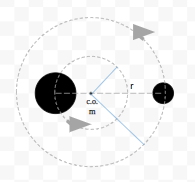Question
Question: A double star consists of two stars having masses M and 2M. The distance between their centres is eq...
A double star consists of two stars having masses M and 2M. The distance between their centres is equal to r. They revolve under their mutual gravitational interaction. Then, which of the following statements are not correct?
A. Heavier star revolves in an orbit of radius r/3.
B. Kinetic energy of the heavier star is twice the kinetic energy of the other star
C. Lighter star revolves in an orbit of radius 52r
D. All are correct
Solution
Hint: Any two objects revolving under the action of gravity revolves around their common centre of mass. The gravitational force is the same for both the stars.
Formula used: Universal law of Gravitation F=R2GMm
Centripetal force Fc=Rmv2
Kinetic Energy, K.E=21mv2.
Complete Step by step answer:

The force of gravity acting between the stars is an internal force and hence, the two-star system is under the action of no external force. This means that the center of mass of the system remains stationary and the stars revolve around this stationary center of mass.
Now, distance of centre of mass from the heavier star can be found out as:
rcm=m1+m2m1r1+m2r2
rcm=2M+M2M⋅0+M⋅r
rcm=3r
So we see that the distance from the stationary center of mass to the heavier star is 3r. Hence statement A is correct and not our answer.
Similarly, we see that the distance of a lightyear star from the centre of mass is r−3r = 32r. Thus the orbit of the lighter star has a radius 32r. Statement C says that this orbit is 52r, which is incorrect and hence, one of our answers.
Now let's see the kinetic energy relation for stars.
We know that the force experienced by the lighter star and the heavier star are the same in magnitude. We also know that this force is providing the necessary centripetal force for revolution.
So we can equate the centripetal forces of the two stars to get a relation between the speeds of two stars.
Since star A is revolving in a circle of radius 3r, its centripetal force can be given as rAmAvA2=3r2MvA2
Similarly, for star B, the centripetal force would be rBmBvB2=32rMvB2
Since both of these are equal to the gravitational force of attraction, 3r(2M)vA2=32rMvB2
So we see that vA2=4vB2.
Now the kinetic energy is K.E=21mv2.
So
K.EB=21mBvB2=21MvB2..
K.EA=21mAvA2=21(2M)(4vB2)=221MvB2.
So we see that
K.EA=21K.EB
Thus the Kinetic energy of a Heavier star is half that of the other. So option B is also incorrect and hence, another solution to the question.
So options B and C are wrong and hence the solutions to the problem.
Note:
1.) Do read the question properly since the question directs us to mark the incorrect options.
2.) We have assumed the orbits of stars to be circular, which is not true in general. Orbits of planets and stars are elliptical. But for most of the calculations, we assume circular orbits for planets.
